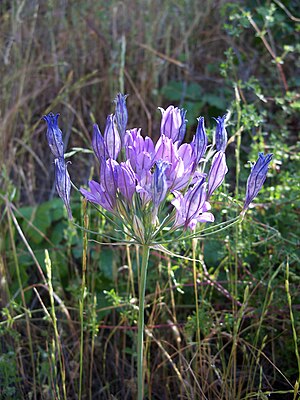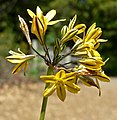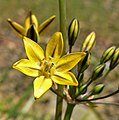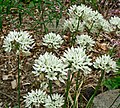Triteleia
| Triteleia | ||||||||||||
|---|---|---|---|---|---|---|---|---|---|---|---|---|

Blue Triteleie ( Triteleia laxa ) |
||||||||||||
| Systematics | ||||||||||||
|
||||||||||||
| Scientific name | ||||||||||||
| Triteleia | ||||||||||||
| Douglas ex Lindl. |
The Triteleia , sometimes Germanized Triteleien or as other genera with similar looking species called spring stars, are a genus of plants from the subfamily Brodiaeoideae in the family Asparagaceae within the order of the asparagus-like (Asparagales).
description


Triteleia species are perennial herbaceous plants . These geophytes form fibrous, enveloped, spherical nodules as persistence organs; In contrast to the leek family (Alliaceae) , they do not form bulbs . One to three basal leaves are formed. The simple, sessile leaves are narrow and keeled. The leaf margin is smooth.
The upright, cylindrical and stiff inflorescence stem has a diameter of 1 to 5 mm. The umbellate inflorescences are similar to those of the leek family (Alliaceae). membranous bracts are initially green (in Triteleia lemmoniae purple) they quickly become dry and brownish. The flower stalks are more or less upright. The small, hermaphrodite, mostly radial symmetry flowers are threefold. The six identical bloom cladding leaves more or less long coalesced. The free area of the bracts is upright to spread out. The colors of the bracts range from white to yellow to blue. There are two circles with three stamens each in each flower. The stamens are fused with the bloom cladding; all the same length or only those of a circle the same length. The free area of the stamens is flattened. In some species there is an appendage to the stamens, then a "crown" is formed (see picture of Triteleia ixioides subspec. Scabra ). The anthers are usually bent away from the scar. The three pistils have become a top permanent ovary grown with only two ovules per ovary chamber. The ovary is green or the same color as the bracts. The 2 to 4 mm long stylus ends in a short three-lobed scar.
Egg-shaped, loculicidal capsule fruits are formed. The black, almost spherical seeds are coarse and irregularly grained or granular.
Systematics and distribution
The genus Triteleia now belongs to the subfamily brodiaeoideae in the family asparagaceae (Asparagaceae). It used to belong to the tribe Brodiaeeae in the subfamily of Allioideae within the family of Alliaceae . The genera of this tribe were all placed in the Themidaceae family and now in the Brodiaeoideae subfamily. It used to be part of the lily family (Liliaceae).
The generic name Triteleia was published in 1830 by David Douglas in John Lindley : Edwards's Bot. Reg. , 15. Synonyms for Triteleia Douglas ex Lindl. are: Calliprora Lindl. , Hesperoscordum Lindl. , Themis Salisb. , Brodiaea sect. Calliprora (Lindl.) S. Watson , Brodiaea subg. Calliprora (Lindl.) Eastwood , Brodiaea subg. Hesperoscordum (Lindl.) Eastwood , Brodiaea sect. Seubertia (Kunth) S. Watson , Brodiaea subg. Triteleia (Douglas ex Lindl.) Eastwood , Seubertia Kunth .
The Triteleia species are only found in North America. Mainly in the western United States , with biodiversity emphasis in northwestern California and southern Oregon . There is only one species outside of the USA: Triteleia guadalupensis , it is endemic to the island of Guadalupe in Baja California .
The genus Triteleia includes 16 species :
- Triteleia bridgesii (S.Watson) Greene : It occurs from southwest Oregon to northeast California.
- Triteleia clementina Hoover : It is endemic to the island of San Clemente off the southern coast of California.
- Triteleia crocea (Alph. Wood) Greene : It occurs from southwest Oregon to northern California.
- Triteleia dudleyi Hoover : It only occurs in California.
- Triteleia grandiflora Lindl. : It occurs from southwestern Canada to northern California.
- Triteleia guadalupensis L.W. Lenz : It is endemic to the island of Guadalupe in Baja California.
- Triteleia hendersonii Greene : It occurs from southwest Oregon to northwest California.
- White Triteleie ( Triteleia hyacinthina (Lindl.) Greene ): It occurs from southwestern Canada to central California.
- Yellow Triteleie ( Triteleia ixioides (WTAiton) Greene ): It occurs in Oregon and California. There are five subspecies.
- Blue Triteleie ( Triteleia laxa Benth. ): It occurs only in California.
- Triteleia lemmoniae (S.Watson) Greene : It is the only species found in Arizona at altitudes between 1,000 and 3,000 meters.
- Triteleia lilacina Greene : It occurs in northern California.
- Triteleia lugens Greene : It occurs in western California.
- Triteleia montana Hoover : It occurs in the Sierra Nevada of California.
- Long-stemmed Triteleie ( Triteleia peduncularis Lindl. ): It is native to the northern Californian coastal mountains at altitudes between 0 and 800 meters, often on serpentine .
- Triteleia piutensis Kentner & KESteiner : It occurs in California and was first described in 2014.
Hybrids :
- Triteleia × tubergenii L.W. Lenz is a hybrid between Triteleia laxa and Triteleia peduncularis
- Triteleia × versicolor Hoover is a hybrid between Triteleia hyacinthina and Triteleia ixioides . It occurs in California.
No longer belongs to the genus:
- Triteleia uniflora Lindl. ⇒ Ipheion uniflorum (Lindl.) Raf.
use
The starchy tubers can be eaten raw or cooked. They were used as food for the North American indigenous people. Depending on the type, they taste differently good. The young capsule fruits of Triteleia grandiflora are also used as a spice.
There are a few varieties of a few species that are used as ornamental plants.
photos
swell
- J. Chris Pires: Triteleia. , P. 338 - the same text online as the printed work , In: Flora of North America Editorial Committee (ed.): Flora of North America North of Mexico. Volume 26: Magnoliophyta: Liliidae: Liliales and Orchidales , Oxford University Press, New York and Oxford, 2002. ISBN 0-19-515208-5
Individual evidence
- ^ J. Chris Pires: Triteleia. , P. 338 - the same text online as the printed work , In: Flora of North America Editorial Committee (ed.): Flora of North America North of Mexico. Volume 26: Magnoliophyta: Liliidae: Liliales and Orchidales , Oxford University Press, New York and Oxford, 2002. ISBN 0-19-515208-5
- ^ A b c Triteleia in the Germplasm Resources Information Network (GRIN), USDA , ARS , National Genetic Resources Program. National Germplasm Resources Laboratory, Beltsville, Maryland.
- ↑ a b c d e f g h i j k l m n o Rafaël Govaerts (Ed.): Triteleia - data sheet at World Checklist of Selected Plant Families of the Board of Trustees of the Royal Botanic Gardens, Kew. Retrieved August 31, 2016.
- ↑ Entries on Triteleia at Plants For A Future
Web links
- Triteleia at the pacificbulbsociety .







